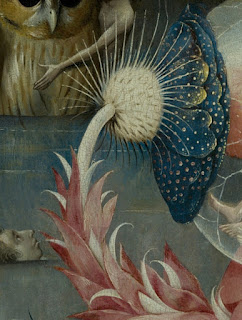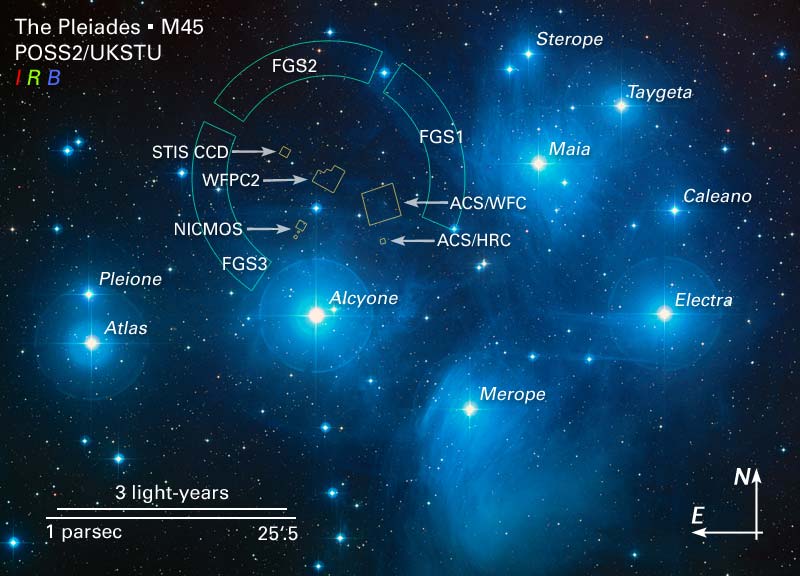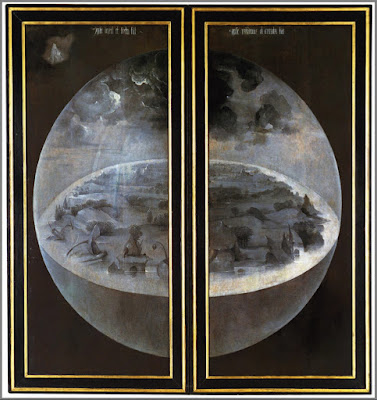 |
| The outside of the triptych. The central table is 220x195cm and both side tables 220x97cm |
Hello and welcome here :)
Today I have the absolute pleasure of bringing to you a little bit of an analysis of one of the most fascinating paintings (to me). The Garden of Earthly Delights...sigh... just by the name you know it is going to be good! Gotta love it.
I stumbled upon this piece in ♥♥History of Art♥♥ class (History of Art&Literature best subjects evaaar) and although I had liked the majority of things so far (sorry Romanic paintings aren't mah thing, you know...), this clicked within me like none other. It has so many details and it is so imaginative. It surprised me a lot because I've always had these kind of little world imagining things in my head and this was like the closest thing because of the style of tiny nonsense things. I just find it very compelling.
This is a very long post, we are going to go through historical and cultural context of the piece and many other things such as the analysis of the structure and the materials it is done with etc.
Hope you can appreciate and enjoy it.
Let's get started.
***I've listened to whole hours of music while writing all of this but right now I'm listening to this***
The Garden of Earthly Delights is one of the summit works of Gothic painting and flemish style masterpiece and the most enigmatic of Hieronymus Aeken, as known as "the Bosch" (1450-1516). Its amazing scenes, creatures that defy all logic and the strange symbolism used turn this painting and its author into one of the most studied ones in recent times.
History of the picture
It was made for Henry II of Nassau. The first owners of the work were the members of the house of Nassau. The first Bosch's biographer, Antonio de Beatis (a man travelling in the entourage of the Cardinal of Aragon, in 1517) got to see it in their palace in Brussels. His description leaves no doubt: "Then there are some tables with various extravagancies, in which he imitated seas, skies and fields, woods and many other things, some that leave a seashell, others defecate cranes, men and women, black and white in different acts and ways, birds, animals of all classes and performed with great naturalism, things so nice and fantastic that in no way could be described to those who do not have seen it".
The painting was inherited by William of Orange, leader of the Dutch revolt against the Habsburg crown. Later it was seized by the Duke of Alba, and was included in his inventory, which for that reason was written the 20 January 1568. The Duke left the paintings to Mr. Fernando, his natural son and Father prior of the Order of San Juan.
Later Philip II acquired it in the auction of the assets of Mr. Fernando and sent it to the Monastery of the Escorial the 8th of July of 1593. It was placed in the king's bedroom, where it remained until his death. At the start the painting was called "A painting on the variety of the world". Later on, "The painting of the strawberries". In 1912, cataloging the works of the Prado Museum, it was known as "The triptych of carnal pleasures". From there on it takes its current name "The Garden of Delights" and "The Garden of Earthly Delights".
1. Chronological, historical and cultural context
Historical Background
We are in the Middle Ages (from the late XII century to the XV century): there are major social and economical changes. A more optimistic view of the world was being implemented, and Gothic was the artistic manifestation of this new mentality typical of urban culture.
-Economy: improvements in agricultural production: the development of trade and crafts (guilds).
-Economy: improvements in agricultural production: the development of trade and crafts (guilds).
-Society: demographic growth. Renaissance of the cities. Continuation of estate society; emergence of the bourgeoisie. The nobility is urban and courtesan.
-Politics: strengthening of the power of the kings. Allied with the church (bishops) and the bourgeoisie.
-Religion and Culture: emergence of the mendicant orders (new mentality). God is more humanized, which loves, forgives and promises salvation to men. Assessment of the world of the senses (Aristotle). Role of Universities. Scientific and technical development.
The revitalization of the cities and the bourgeoisie brings the construction of great cathedrals to accommodate the growing number of believers and become the new symbol of economic might of the new cities. The higher and greater was the cathedral, the largest and richest were the city burghers who financed it and therefore attracted more traders. The cathedrals were symbols of the importance of the city. They also built civilian buildings: palaces, town halls, markets...
Early fifteenth century: the stage of maximum splendor of the Spanish Monarchy, with the conquest and exploitation of American gold and silver. Great ideological rigidity based on the defense of the Christian religion and the confrontation with Protestants. Importance of the Inquisition (repression).
Since 1477 Flanders passed, by inheritance, in the hands of the Habsburg dynasty, to finally end up, with Carlos I, joining the Spanish Empire.
The development and growth of the cities was linked to the production of woolen fabrics: Bruges became the main commercial centre of Occidental Europe. This bourgeois society values what is practical even in religion (the divine spirit can be found in each one of the little things). We are, therefore, in a realist period.
Cultural context
The foundation of universities, independent or controlled by ecclesiastical bodies, led to the final separation of the culture respecting the monastic scriptoria. Thus, the cities were great cultural centers. As a symbol of this new situation of prosperity and strength, they began to build great cathedrals.
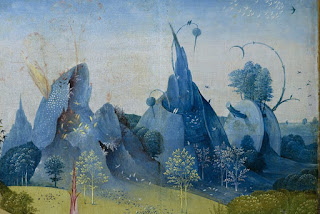 New religious orders such as the Franciscans and Dominicans, known as mendicant orders, developed their activities in cities devoted to helping the poor through almsgiving, and also facilitated the change of mentality. They advocate a return to evangelical poverty and become leaders of the new intellectuals of the Middle Ages. In front of the resignation of the world of contemplative Orders appears a new humanism in the predications of St. Francis of Assis.
New religious orders such as the Franciscans and Dominicans, known as mendicant orders, developed their activities in cities devoted to helping the poor through almsgiving, and also facilitated the change of mentality. They advocate a return to evangelical poverty and become leaders of the new intellectuals of the Middle Ages. In front of the resignation of the world of contemplative Orders appears a new humanism in the predications of St. Francis of Assis.
The fourteenth century is the era of the great expansion of mendicant Orders: they spread throughout Europe and suggest a vision of religion that moves on from the severity of the Romanic period.
But these economical and social changes bring a new mentality, secularization of culture, which would affect all strata of feudal society and will be reflected in art. But religion is still very important in life in the Gothic.
New patrons appeared: many works, especially in sculpture and painting, were commissioned by the bourgeoisie and the unions, royalty or nobility who joined the church.
In most cases artists remain anonymous and continued to be considered skilled craftsmen. They remain enrolled in the guilds, controlled and helped, many of them did not even sign their works, just the most prominent painters do so.
The work of Bosch is a reflection of the rapid changes of the XV and XVI centuries: he lives the changes of two periods, the end of the medieval world and the beginning of the Renaissance period, a time of social and economic changes. The crisis of values, heresy, plagues and wars in northern Europe are also new circumstances that may also help to explain the work of this painter. The insecurity of the new times may also eventually lead to religious fanaticism (processions of penitents), to the hardness of the religion fights of the XV century, and to social and bloody repressions.
2. Style
It belongs to Flemish painting (Early Netherlandish). The technique used was oil, this allows to paint very intensely colorful tones as well as transparent glazes to soften the tone of the table.
With the spatial conception of the scenes, he intuitively gets an illusionist landscape in which the figures are inserted. The detail is painstaking extraordinary and there's a variety of subjects: religious and bourgeois.
He has the will to represent things as the human eye sees them, with great detail: hence the importance portrait acquires, as well as the other various details involved in pictorial composition, that's how this favors, paradoxically, the symbolism of the elements represented.
About the figure of Jerome van Aken figure "The Bosch" (1453-1516) is little what we know with certainty. Born into a family of artisan painters, he developed his entire artistic life in the small town of Hertogen Bosch (Duke's Bosch), in Holland. He probably learned his job in his father's or one of his uncles workshop.
At the beginning of the sixteenth century he already was an artist established in the Netherlands, commissioned by high public figures, and even his fame extended outside of the country. His economic relieved situation granted him a certain freedom to express his ideas in painting more personally than most painters of the time. His religious, alchemical, heretics, humanists relations etc. have been investigated in order to relate them to his work, full of enigmatic symbolism that goes beyond any artistic movement.
Bosch's lives the change between two eras, its roots are in the medieval tradition but are already announced in the Renaissance humanism. Bosch is the result of the work of apocalyptic visions that during the Middle Ages, the church had to scattered. It was a time when religious crises created doubts and anxieties, heresies infiltrated all levels of society and the church itself was questioned. In rural areas, where Bosch lived, this phenomenon of religious instability was lived most intensely. No wonder, then, that in such a fragile religious area the Lutheran theses prevailed, trying to bring order to a Church more concerned about worldly affairs than spiritual matters.
Through his paintings, removed from the traditions dominant in Flemish painting and imbued with boundless fantasy and popular experience, the Bosch makes a critique of the institutions and customs of his environment, in line with other spiritual movements of the time (Erasmus of Rotterdam...).
His remarkable works include, in addition to The Garden of Earthly Delights, the Hay Wagon, The Seven Deadly Sins, The Extraction of the Stone of Madness and The Temptations of St. Anthony.
While we can relate his painting to the Flemish school, he really is a world of his own, as it is absolutely personal. The detail, the way he treats the coloring and the creation of spaces and volumes are typical of the Flemish school. But the themes and how he deals with the symbolism distances him from other painters. His originality comes from his strange allegoric compositions with monsters and fantastic figures, with an unusual iconography and satirical details. But also for his sense of the shapes: small figures with great detail and remarkable dynamism. He paints alla prima, with a few tweaks.
Transcendence of the work
 Bosch had a great dissemination as many prints were made and they cast their visions across the Western world. Suffice to say, however, that he did not have many followers, although the old painters such as Brueghel for example, maintain aesthetics and irony that are close to him. The great thoroughness in the elaboration and the execution with great detail of what he represented, together with the enormous symbolism, deemed the Bosch to be the direct forerunner of the surrealism of the twentieth century, and that this movement was inspired by him: Dalí, for example, recreated one of his works in the Temptations of St. Anthony, or the tree man inspires the biomorphic face of The Great Masturbator.
Bosch had a great dissemination as many prints were made and they cast their visions across the Western world. Suffice to say, however, that he did not have many followers, although the old painters such as Brueghel for example, maintain aesthetics and irony that are close to him. The great thoroughness in the elaboration and the execution with great detail of what he represented, together with the enormous symbolism, deemed the Bosch to be the direct forerunner of the surrealism of the twentieth century, and that this movement was inspired by him: Dalí, for example, recreated one of his works in the Temptations of St. Anthony, or the tree man inspires the biomorphic face of The Great Masturbator.
Hieronymus Bosch is one of the most enigmatic artists but still has many admirers today: although the meaning of many of his works is unclear.
3. Formal characteristics; composition; techniques; support.
The work is a triptych (three tables) made with oil paint.
Formal elements: The work presents an apparent importance of color, but what predominates is the drawing, meticulous and precise. Outside, representing the creation of the world, is made in grisaille (composition painted with a range of grays, black and white) in muted tones of gray and green, which contrast with the explosion of color when we open the table or triptych.
 Here, there are also different color ranges used to represent the various environments and the themes: Paradise is predominantly green, blue and yellow (cool colors that convey an air of purity and renewal); in the Garden still predominates green, but it is more yellowish, it includes figures which stand out for the clarity and the light emitting that their white, bare bodies emit, and finally, in Hell we find red, brown and black (warm colors and symbol of evil).
Here, there are also different color ranges used to represent the various environments and the themes: Paradise is predominantly green, blue and yellow (cool colors that convey an air of purity and renewal); in the Garden still predominates green, but it is more yellowish, it includes figures which stand out for the clarity and the light emitting that their white, bare bodies emit, and finally, in Hell we find red, brown and black (warm colors and symbol of evil).
So in the table, the light contrasts with the darkness, symbol of sin (the red tone of Hell reminds us of fire).
Thanks to the postures and the variety of the represented groups we can say that it is full of dynamism.
The landscape is not credible but it is created in kind of a real enough way so we can imagine, it's the abolition of space somewhere where time has ceased to exist.
It has no interest for perspective but acquires visual profundity by varying the sizes of what is represented. The figures are so small, well outlined and very thorough but rather flat; which allows the artist to represent a lot of gestures and scenes with a clean exhibition, although they have some stereotyped character.
Compositional Specifications
The line of the horizon is high to to achieve the vision of all the layouts that, despite their independence, melt with one another.
Technical specifications and Support
This is an oil painting on wood. The support timber must be covered with a layer of plaster. Later it is scraped and they add four or five layers of glue, to reduce the porosity of the wood, plus a primer of drying colors. Then they apply with a brush pigments dissolved in many drying oils, such as flaxseed, that work as a binder. It dries up slowly so it allows adjustments and glazes.
4. Themes represented. Literary model. Meaning and function
Topic
It is an allegory of the pleasures of life, which are considered ephemeral and the terrible consequences that result. The triptych develops the story of the world and the progression of sin: it begins in the outer tables with the Creation of the world and continues in the interior with the origin of sin in Paradise (creation of Eve) on the left, on the center there's a world dominated earthly pleasures, and it ends with the torments of Hell at the right. The creation of women seems to be the trigger of the scene, dedicated to the sin of Lust and its punishment.
Source of the topic
The iconographic program of the Garden of Delights, is inspired, very openly, in the Old Testament, especially in the book of Genesis. It is enriched with a medieval symbology and iconography: Dutch manuscripts, engravings, legends, etc. but also by the overflowing imagination of the painter.
Iconography
 The Garden of Delights, today, still is an iconographic hieroglyphic difficult to interpret. Overall it is a very personal representation of the world through a triple sequence: Creation, Paradise, The Garden of Earthly Delights, and Hell. The great proliferation of symbols it contains, however, does raise serious doubts about the intentions of the author when he conceived the work.
The Garden of Delights, today, still is an iconographic hieroglyphic difficult to interpret. Overall it is a very personal representation of the world through a triple sequence: Creation, Paradise, The Garden of Earthly Delights, and Hell. The great proliferation of symbols it contains, however, does raise serious doubts about the intentions of the author when he conceived the work.
In its exterior when it is closed, the triptych shows the third day of the creation of the world narrated in Genesis, represented by a crystal sphere with the earth inside: the Bosch follows the conventions of his time and represents the earth flat.
Once opened, we find an exceptional triptych, full of images of a an overflowing fantasy.
Left panel: The Garden of Eden
 The table of Paradise represents the creation of Eve from Adam by God, the landscape is idyllic, full of rocks, exotic plants and real and fantastic animals. In the center there is a pond with the fountain of life.
The table of Paradise represents the creation of Eve from Adam by God, the landscape is idyllic, full of rocks, exotic plants and real and fantastic animals. In the center there is a pond with the fountain of life. 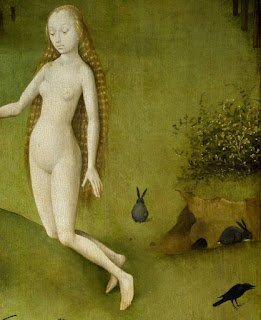 Although the tree of forbidden fruit with the snake already exists, Adam and Eve are still free of sin. It is the origin of the sin of lust which develops in the central table. The Bosch reproduces the medieval mentality that blames Eve as the beginning of the evils of humanity.
Although the tree of forbidden fruit with the snake already exists, Adam and Eve are still free of sin. It is the origin of the sin of lust which develops in the central table. The Bosch reproduces the medieval mentality that blames Eve as the beginning of the evils of humanity.
He presents a figure of a very young God, very frequent convention in XV century Dutch literature. As usual in the Bosch, Paradise does not exist without a foreshadowing of the devil, which appears as a moat dark pit on the foreground, from which a variety of creatures come out.
Central panel: The Garden of Delights
It is a continuation of the previous painting through the pound with five fountains, which represent the five planets known to man back then.
In the central zone humanity rides animals which represent their vices, surrounding a small lake that dramatizes the bath of Venus, represented by women of all races. The rest is made up of many animals, some real and some fantastic and a big number of other men and women with lewd poses, surrounded by strange objects, spheres that seem matrices, tropical birds, fish, impossible plants, exotic fruits, symbolizing lust. The group expresses a libertine life, in which people have abandoned themselves to the production of pleasure and the temptations of the "flesh".
In the Middle Ages it was popular to believe that lust was the origin of all sins and that the rest appeared after. It was also believed that the source of this temptation and sin was the woman.
Although at first impression disorder seems to reign, the scene is sorted into three levels:
- The top, with details that are hardly perceived by both its small size and its rarity, (winged humans, gryphons...). It appears dominated by fantastic buildings, among which the Fountain of the Four Rivers in the Earthly Paradise, false source of Paradise, unstable, stands out, threatening to ruin with its walls.
- In the center of the composition, the big cavalcade of desire, turning around in a circle around a pond where groups of women bathe.
 - in the lower level, sexuality manifests itself in a thousand ways, both in the actions of the mass of men and women, all of them of unequivocal erotic sign, as in the sexual connotations of plants, fruits and animals. In the angles appear two peculiar attention focus. On the left, a group that points the table on the left (Paradise) to Eve, stressing the role played into temptation. On the right, the Cave, there are Adam and Eve, where they see what is happening in the world because of their cause, and Adam, with his finger accuses Eve.
- in the lower level, sexuality manifests itself in a thousand ways, both in the actions of the mass of men and women, all of them of unequivocal erotic sign, as in the sexual connotations of plants, fruits and animals. In the angles appear two peculiar attention focus. On the left, a group that points the table on the left (Paradise) to Eve, stressing the role played into temptation. On the right, the Cave, there are Adam and Eve, where they see what is happening in the world because of their cause, and Adam, with his finger accuses Eve.
The Garden of Earthly Delights is a garden of the false misleading earthly pleasures, a consequence of the original sin. Every detail of this "world upside down" warns us: it is the paradisiacal dream i, it is the kingdom of what is temporary. On the table of the right the time of penance and punishment for sinners for their sins has arrived (lust, greed, pride, love games, music sensuality, customs of the clergy...).
Right panel: Hell

 The last part end of the triptych represents Hell. It is the scene that represents the results of a life of immorality and sin, where artist describes different punishments for different sins. The same characters from the central table purged their sins in Hell. Beauty, pleasure and lust are fleeting, temporary and false. "The pleasures of the false earthly paradise lead to eternal damnation". It is the eternal damnation of the whole of humanity. This closes the cycle, and society is punished for being seduced by the pleasures that were offered in the Garden the Earthly Delights.
The last part end of the triptych represents Hell. It is the scene that represents the results of a life of immorality and sin, where artist describes different punishments for different sins. The same characters from the central table purged their sins in Hell. Beauty, pleasure and lust are fleeting, temporary and false. "The pleasures of the false earthly paradise lead to eternal damnation". It is the eternal damnation of the whole of humanity. This closes the cycle, and society is punished for being seduced by the pleasures that were offered in the Garden the Earthly Delights.
The landscape has changed significantly and is now fearsome, dominated by black and red fire; everything indicates destruction and punishment under a dark and eerie night. On the top there is a city on fire represented, the water of the ponds now is dark and rotten, and around them there are whitish remnants of skeletons. In the center there is the tree-man. His body is a hollow egg, his legs are two tree trunks submerged in boats, his head is made of a great disc and a bagpipe, while his face turned towards us, stares at us with melancholic look. The painting is completed with a collection of grotesque creatures and scenes of cruel torture addressed to cause the suffering of sinners; including a killing machine that consist of two ears supporting a razor blade.
Meaning: iconology
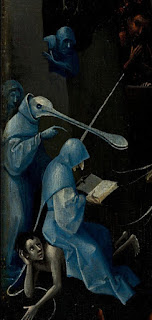 The triptych shows in an allegorical manner that the pleasures of life are ephemeral and that the consequences of letting them take over are suffering, disgrace and the impossibility of being happy.
The triptych shows in an allegorical manner that the pleasures of life are ephemeral and that the consequences of letting them take over are suffering, disgrace and the impossibility of being happy.
It presents a closed and coherent thematic cycle: what started badly with original sin becomes a world based on material pleasures and in the end there can be only be the suffering of the eternal punishment.
It is a painting of enormous symbolic complexity:
- fruit and animals, symbols of sexual pleasures and its expiry.
- apples represent women's breasts and fish relate to the phallic organ.
- inversion symbols: animals are bigger than people, animals hunters of men...
- symbols of evil: owl and snake.
- alchemical symbols
The orthodox interpretation that historians have made of the The Garden of Earthly Delights would be a warning against earthly pleasures and temptations, exemplified in the figure of Eve and its fatal consequences that can carry, exemplified in the punishments of hell. According to this interpretation, the picture was intent at moralizing which would have been understandable to the people of the age; thus the picture can be understood as a warning against the pleasure of "flesh" from the author, origin of terrible punishment and even the destruction of the world, as the burning towns surrounded by fire in the right distance seem to imply. So you can say that this painting is a work in the same apocalyptic line of many medieval works that can be seen in doorways and other altarpieces.
This painting is certainly difficult to understand, as one has to have a certain knowledge of the Old Testament in order to relate the iconography with the historical context and mindset that surrounded the man who lived between two centuries, two eras and two different artistic movements, and that knew to equilibrate them so well in this triptych that at first seem religious but then becomes secular.
Function
The work can be considered a sermon, a moralizing allegory through which the artist tries to remember how earthly pleasures are ephemeral and just how terrible is the condemnation derived.
The function of the triptych is, therefore, religious and moralistic in nature: so heartbreakingly but also pessimistically shows his society that salvation should be achieved at the expense of great hardship and privation, otherwise what awaits us, the most mortals, is suffering in hell.
It is, in short, a harsh criticism of the animality of man, subject to the temptations of the flesh and pleasure. Sin is the junction between the three tables: in Paradise, the snake and Eve; in the World, the deception of the senses, and in Hell, the punishment.
Bosch wants to show us a false Paradise, and how its beauty expires and leads, especially men (theoretically, women were there already) to ruin, and the condemnation of hell, a very common subject in medieval literature.
 |
| I personally love this scene |
I find everything about this painting so interesting, I can spend hours staring at it it is just so great. It would be wonderful to be able to see it in person one day!
That's it! After several days of typing I've said what I wanted to say about this magnificent piece.
So, how do you see this?
Hope at least you see this with new eyes.
If you wish to dig in further I leave a few short videos about the painting that show details in more detail!
See you,
B.
 |
| Silly doodle from 5 years ago or so (thought that here wouldn't be as off key heh) |



